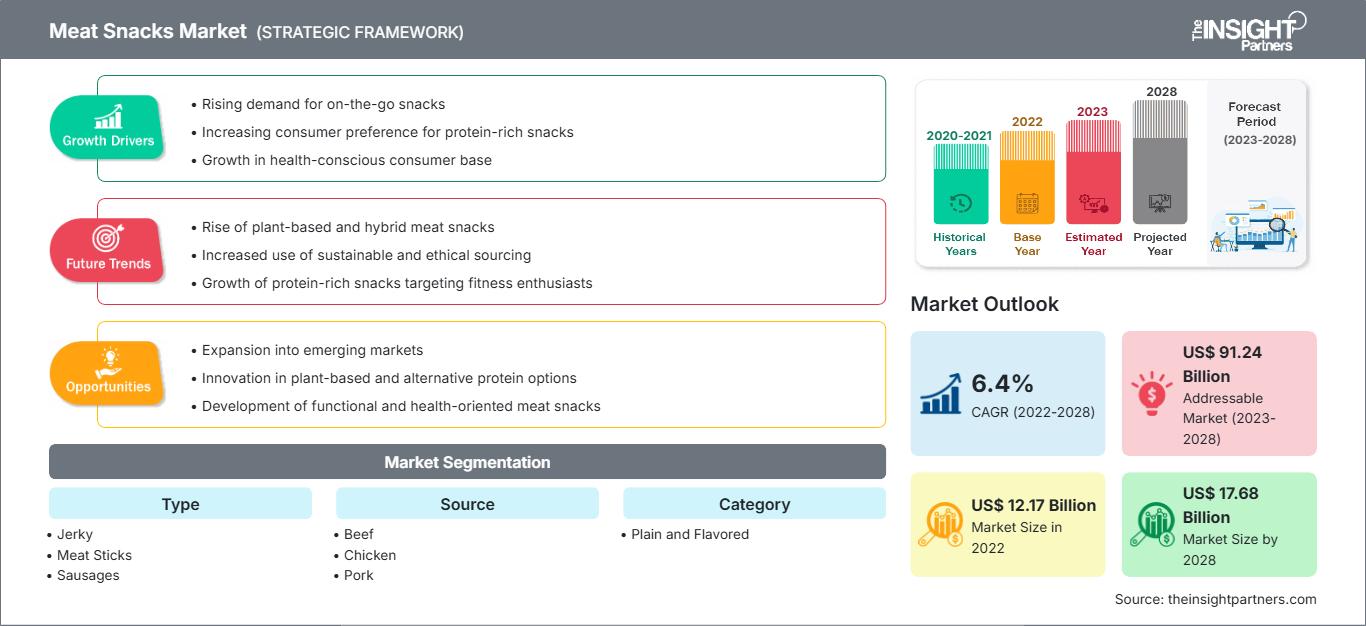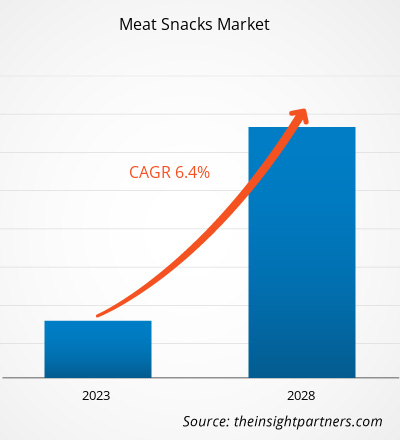[Informe de investigación] Se espera que el tamaño del mercado de snacks de carne crezca de US$ 12.169,01 millones en 2022; se estima que crecerá a una CAGR del 6,4% entre 2022 y 2028.
Los snacks de carne están ganando mucha popularidad entre los consumidores gracias a su alto contenido en proteínas, hierro, creatina y varias vitaminas. Además, están disponibles en una variedad de sabores dulces y salados, lo que aumenta su demanda. Actualmente, la mayoría de los snacks de carne disponibles en el mercado se elaboran con carne de res o cerdo. Sin embargo, debido a la creciente preocupación por la salud y el bienestar, las personas están optando por fuentes de proteína animal más magras. La carne de res, cerdo y cordero tiene un mayor contenido de grasas saturadas que el pollo. Debido a la creciente prevalencia de la obesidad y las enfermedades cardíacas, los consumidores prefieren productos cárnicos bajos en grasa. Este factor impulsa la demanda de snacks de carne de pollo.
En 2021, América del Norte concentró la mayor participación en el mercado de snacks de carne, mientras que se estima que Asia Pacífico registrará la tasa de crecimiento anual compuesta (TCAC) más alta durante el período de pronóstico. La carne de ave y de cerdo son ampliamente consumidas en Asia Pacífico. Según la Oficina Nacional de Estadística, la producción de carne de cerdo en China aumentó un 35,9 % en 2021 con respecto al año anterior. Además, la industria avícola está creciendo rápidamente en China, India, Japón y otros países de Asia Pacífico, debido al aumento significativo de la demanda de carne de ave. Se espera que estos factores impulsen el crecimiento del mercado de snacks de carne en Asia Pacífico durante el período de pronóstico.
Personalice este informe según sus necesidades
Obtendrá personalización en cualquier informe, sin cargo, incluidas partes de este informe o análisis a nivel de país, paquete de datos de Excel, así como también grandes ofertas y descuentos para empresas emergentes y universidades.
Mercado de snacks de carne: Perspectivas estratégicas

- Obtenga las principales tendencias clave del mercado de este informe.Esta muestra GRATUITA incluirá análisis de datos, desde tendencias del mercado hasta estimaciones y pronósticos.
Impacto de la pandemia de COVID-19 en el mercado de snacks de carne
El sector de alimentos y bebidas enfrentó desafíos inesperados debido a la pandemia de COVID-19. Restricciones gubernamentales, como confinamientos, paros de producción, prohibiciones de viaje y restricciones fronterizas, interrumpieron las cadenas de suministro globales en 2020. Las interrupciones en las operaciones de fabricación y abastecimiento de materias primas obstaculizaron el crecimiento del mercado de snacks de carne durante los primeros meses de la pandemia. Sin embargo, la demanda de snacks de carne congelados aumentó en medio de esta crisis global debido a las compras de pánico por parte de los consumidores. Los consumidores en países como Estados Unidos, Canadá, Alemania y el Reino Unido adoptaron drásticamente una dieta basada en plantas. Según un estudio de The Vegan Society, uno de cada cinco británicos redujo su consumo de carne desde el inicio de la pandemia. Este factor obstaculizó la demanda de snacks de carne. En 2021, el mercado experimentó una recuperación, ya que los gobiernos anunciaron la flexibilización de las restricciones impuestas previamente y permitieron a los fabricantes trabajar a plena capacidad. Por lo tanto, el aumento de los volúmenes de producción y la mejora de las operaciones de la cadena de suministro impulsaron el crecimiento del mercado de snacks de carne. La pandemia tuvo un impacto desigual en el mercado mundial de snacks de carne.
Perspectivas del mercado
Desarrollos estratégicos de los actores clave del mercado para impulsar el mercado de snacks de carne durante el período de pronóstico
Las empresas están ampliando su capacidad de producción para satisfacer la creciente demanda de snacks de carne en todo el mundo. Por ejemplo, en abril de 2022, Jack Link's, una de las marcas líderes de snacks de carne en EE. UU., invirtió 450 millones de dólares en la construcción de una nueva planta de fabricación en Georgia. De igual manera, en julio de 2020, Conagra Brands invirtió 100 millones de dólares en la ampliación de su planta de producción de snacks de carne en Ohio, EE. UU., para satisfacer la creciente demanda de productos cárnicos Slim Jim y salchichas ahumadas Duke's. Se espera que estas estrategias impulsen significativamente el crecimiento del mercado de snacks de carne durante el período de pronóstico.
Información sobre tipos
Según el tipo, el mercado de snacks de carne se segmenta en cecina, palitos de carne, salchichas y otros. El segmento de cecina tuvo la mayor participación en el mercado en 2021. Sin embargo, se espera que el segmento de palitos de carne registre la mayor tasa de crecimiento anual compuesta (TCAC) entre 2022 y 2028. La cecina es el snack de carne más popular. Los fabricantes están desarrollando versiones más saludables de cecina para satisfacer las nuevas preocupaciones de salud de los consumidores. Por ejemplo, en septiembre de 2019, Werner Gourmet Meat Snacks, fabricante estadounidense de cecina y snacks, lanzó un nuevo producto en la categoría de snacks de carne: una cecina sin azúcar elaborada con carne de res alimentada con pasto. Se espera que estos productos tengan una gran aceptación entre los consumidores, lo que impulsará el crecimiento del mercado de snacks de carne durante el período de pronóstico.
Información sobre fuentes
Según fuentes, el mercado de snacks de carne se segmenta en carne de res, pollo, cerdo y otros. El segmento de res tuvo la mayor participación de mercado en 2021. Sin embargo, se proyecta que el segmento de pollo registre la mayor tasa de crecimiento anual compuesta (TCAC) durante el período de pronóstico. La carne de res, cerdo y cordero tiene un mayor contenido de grasas saturadas que el pollo. Por lo tanto, el alto consumo de carne de res, cerdo, cordero y otras carnes con alto contenido de grasas saturadas aumenta el nivel de colesterol en sangre, lo que a su vez aumenta la vulnerabilidad a enfermedades cardíacas, obesidad e hipertensión arterial. Por lo tanto, los consumidores prefieren cada vez más productos cárnicos a base de pollo para satisfacer sus necesidades proteicas y mantener un bajo consumo de calorías. Se espera que este factor impulse el crecimiento del mercado del segmento de pollo en los próximos años.
Información sobre el canal de distribución
Según el canal de distribución, el mercado de snacks de carne se segmenta en supermercados e hipermercados, tiendas de conveniencia, venta minorista en línea, entre otros. El segmento de supermercados e hipermercados representó la mayor participación de mercado en 2021, mientras que se espera que el mercado de venta minorista en línea experimente el mayor crecimiento durante el período de pronóstico. Las tiendas minoristas en línea ofrecen diversos productos con importantes descuentos. Además, los consumidores pueden comprar cómodamente productos de forma remota a través de plataformas de comercio electrónico como Amazon.com, Walmart y eBay. Los consumidores prefieren cada vez más las plataformas de venta minorista en línea para comprar snacks de carne debido a la disponibilidad de una amplia gama de productos de diferentes marcas a precios reducidos y la disponibilidad de servicios de entrega a domicilio. Este factor impulsa el crecimiento del mercado en el segmento de venta minorista en línea.
Tyson Foods Inc, Bridgford Foods Corporation, General Mills Inc, Werner Gourmet Meat Snacks, Premium Brands, Hormel Foods Corporation, Conagra Brands Inc, Link Snacks Inc, Country Archer Provisions y Organic Valley se encuentran entre los principales actores del mercado de snacks de carne. Estas empresas se centran principalmente en la innovación de productos para ampliar su mercado y adaptarse a las tendencias emergentes. Por ejemplo, en septiembre de 2020, Noel Alimentaria, empresa española, lanzó snacks de carne para llevar, más saludables, bajo la marca "Picalos". La empresa adoptó una tecnología de producción única que deshidrata y hornea lentamente los snacks de forma artesanal, conservando así las cualidades nutricionales de la carne. Se espera que estos productos tengan una gran aceptación entre los consumidores durante el período de pronóstico.
Perspectivas regionales del mercado de snacks de carne
Los analistas de The Insight Partners han explicado detalladamente las tendencias regionales y los factores que influyen en el mercado de snacks de carne durante el período de pronóstico. Esta sección también analiza los segmentos y la geografía del mercado de snacks de carne en América del Norte, Europa, Asia Pacífico, Oriente Medio y África, y América del Sur y Central.
Alcance del informe de mercado de snacks de carne
| Atributo del informe | Detalles |
|---|---|
| Tamaño del mercado en 2022 | US$ 12.17 mil millones |
| Tamaño del mercado en 2028 | US$ 17.68 mil millones |
| CAGR global (2022-2028) | 6,4% |
| Datos históricos | 2020-2021 |
| Período de pronóstico | 2023-2028 |
| Segmentos cubiertos | Por tipo
|
| Regiones y países cubiertos | América del norte
|
| Líderes del mercado y perfiles de empresas clave |
|
Densidad de actores del mercado de snacks de carne: comprensión de su impacto en la dinámica empresarial
El mercado de snacks de carne está creciendo rápidamente, impulsado por la creciente demanda del consumidor final debido a factores como la evolución de las preferencias del consumidor, los avances tecnológicos y un mayor conocimiento de los beneficios del producto. A medida que aumenta la demanda, las empresas amplían su oferta, innovan para satisfacer las necesidades del consumidor y aprovechan las tendencias emergentes, lo que impulsa aún más el crecimiento del mercado.

- Obtenga una descripción general de los principales actores clave del mercado de snacks de carne
Informe destacado
- Tendencias progresivas de la industria en el mercado de snacks de carne para ayudar a las empresas a desarrollar estrategias efectivas a largo plazo
- Estrategias de crecimiento empresarial adoptadas por los actores del mercado de snacks de carne en los países desarrollados y en desarrollo
- Análisis cuantitativo del mercado de 2020 a 2028
- Estimación de la demanda mundial de snacks de carne
- Análisis de las cinco fuerzas de Porter para ilustrar la eficacia de los compradores y proveedores en el mercado de snacks de carne
- Desarrollos recientes para comprender el escenario del mercado competitivo
- Tendencias y perspectivas del mercado, así como factores que impulsan y restringen el crecimiento del mercado de snacks de carne.
- Asistencia en el proceso de toma de decisiones destacando las estrategias de mercado que sustentan el interés comercial.
- Tamaño del mercado de snacks de carne en varios nodos
- Descripción detallada y segmentación del mercado, así como la dinámica de la industria de snacks de carne.
- Tamaño del mercado de snacks de carne en varias regiones con prometedoras oportunidades de crecimiento
- Análisis histórico (2 años), año base, pronóstico (7 años) con CAGR
- Análisis PEST y FODA
- Tamaño del mercado, valor/volumen: global, regional y nacional
- Industria y panorama competitivo
- Conjunto de datos de Excel
Informes recientes
Informes relacionados
Testimonios
Razón para comprar
- Toma de decisiones informada
- Comprensión de la dinámica del mercado
- Análisis competitivo
- Información sobre clientes
- Pronósticos del mercado
- Mitigación de riesgos
- Planificación estratégica
- Justificación de la inversión
- Identificación de mercados emergentes
- Mejora de las estrategias de marketing
- Impulso de la eficiencia operativa
- Alineación con las tendencias regulatorias






















 Obtenga una muestra gratuita para - Mercado de snacks de carne
Obtenga una muestra gratuita para - Mercado de snacks de carne